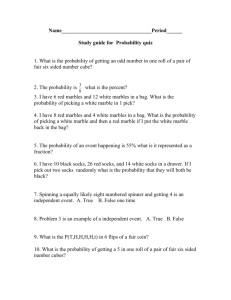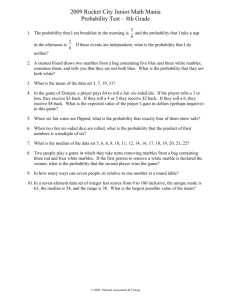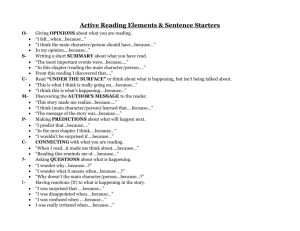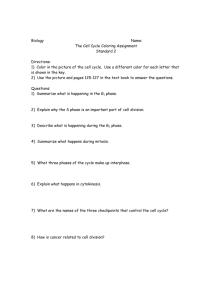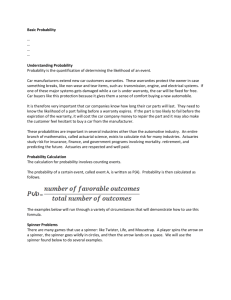Addition Principle of Counting & Mutually Exclusive
advertisement
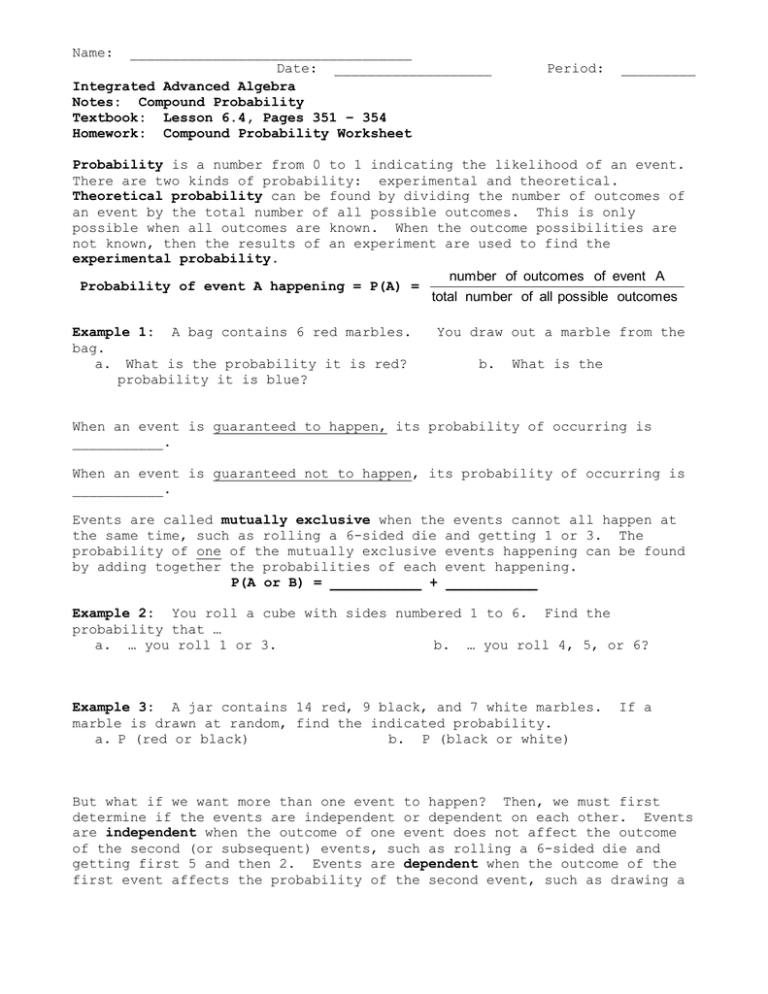
Name: __________________________________ Date: ___________________ Integrated Advanced Algebra Notes: Compound Probability Textbook: Lesson 6.4, Pages 351 – 354 Homework: Compound Probability Worksheet Period: _________ Probability is a number from 0 to 1 indicating the likelihood of an event. There are two kinds of probability: experimental and theoretical. Theoretical probability can be found by dividing the number of outcomes of an event by the total number of all possible outcomes. This is only possible when all outcomes are known. When the outcome possibilities are not known, then the results of an experiment are used to find the experimental probability. number of outcomes of event A Probability of event A happening = P(A) = total number of all possible outcomes Example 1: A bag contains 6 red marbles. bag. a. What is the probability it is red? probability it is blue? You draw out a marble from the b. What is the When an event is guaranteed to happen, its probability of occurring is ___________. When an event is guaranteed not to happen, its probability of occurring is ___________. Events are called mutually exclusive when the events cannot all happen at the same time, such as rolling a 6-sided die and getting 1 or 3. The probability of one of the mutually exclusive events happening can be found by adding together the probabilities of each event happening. P(A or B) = ___________ + ___________ Example 2: You roll a cube with sides numbered 1 to 6. Find the probability that … a. … you roll 1 or 3. b. … you roll 4, 5, or 6? Example 3: A jar contains 14 red, 9 black, and 7 white marbles. marble is drawn at random, find the indicated probability. a. P (red or black) b. P (black or white) If a But what if we want more than one event to happen? Then, we must first determine if the events are independent or dependent on each other. Events are independent when the outcome of one event does not affect the outcome of the second (or subsequent) events, such as rolling a 6-sided die and getting first 5 and then 2. Events are dependent when the outcome of the first event affects the probability of the second event, such as drawing a Name: __________________________________ Date: ___________________ Period: _________ marble from a bag and then drawing another without returning the first marble to the bag. Example 4: Determine whether the following events are independent or dependent. a. Flipping a coin for heads and b. Drawing a spade from a deck, spinning a game spinner for keeping it, then drawing a heart $500. from the deck. The probability of two independent events both happening can be found by multiplying the probabilities of each event happening. P (A and B) = ___________ * ___________ The probability of two dependent events both happening can be found by multiplying the probability of the first event happening times the probability of the second event happening after the first event occurs. P (A and B) = ___________ * _____________________________ Example 5: Twice, you roll a die with sides numbered 1 to 10. Find the probability that … a. … you roll 5, then 7. b. … you roll an even, then an odd. Example 6: Two cards are drawn from a standard playing deck of 52 cards, without replacement. Find the probability that … a. … both cards are kings. b. … the first is a club and the second a heart. Example 7: A jar contains 8 green, 10 blue, and 2 orange marbles. If the marbles are removed and not replaced, find the indicated probability. a. P (green and then blue) b. P (orange, then orange, and then green) $300 $500 $600 Example 8: The game spinner below has eight congruent sections. If the arrow is spun twice, find the indicated probability of the first event and then the second event occurring. a. $800 $100 $200 $700 $400 P ($100 and then $800) Name: __________________________________ Date: ___________________ b. P (greater than $400 and then greater than $600) c. P (less than $800 and then less than $200) d. Period: _________ P (two spins have a sum of $800)
